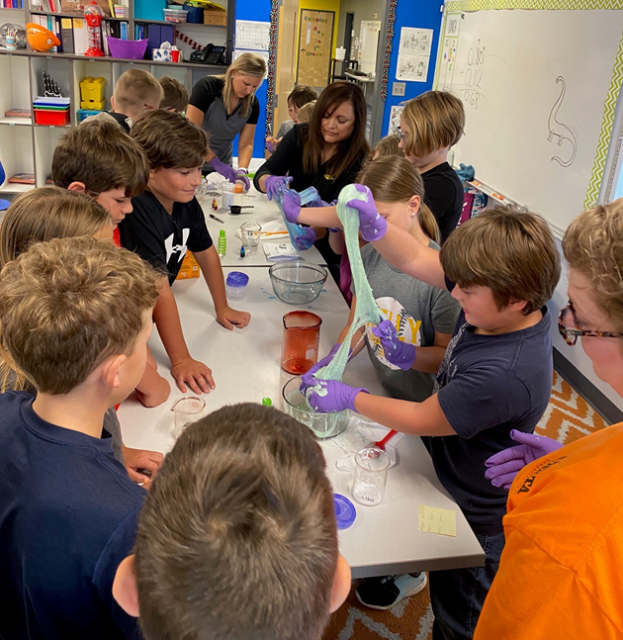No, there weren’t any ghosts roaming the halls! But there were several female construction company employees engaged in classroom activities producing “slime.”
Laurel McClelland, Kari Wagner, and Taylor Kirn with the Delta Companies Inc. introduced the concept of crosslinking in chemistry to approximately 20 students in the Kelso C-7 School District. The 3rd grade class of Mrs. Jaime Burger and the 4th grade class of Mrs. Michaella Gantz in New Hamburg, Missouri (Go Falcons!) participated in “The Science of Slime” presentation.
Laurel, Kari, and Taylor introduced the science of liquid asphalt binder by explaining how it is used in the construction of asphalt pavements. They discussed the various properties available in liquid asphalt and the impact those have on asphalt pavements, including stiffness and elasticity. The students were able to handle various grades of liquid asphalt binder – pulling and stretching or breaking the binder with their hands. (Liquid asphalt binder is typically processed and used at temperatures in excess of 300 degrees; however, the asphalt used in the classroom was cooled to room temperature and was safe to be handled.)

To demonstrate crosslinking, which is the process by which chemical bonds are formed between atoms of two polymer chains, they used paper clips and rubber bands. The paper clips were linked together to form a strong and long “polymer chain” and the rubber bands were added to provide elasticity. Once the bond has been formed, it’s a crosslink.
A similar process is utilized to modify liquid asphalt binders with polymers to construct more flexible and resilient pavements.
Then, the fun stuff happened.
Several students were selected to come up to the front of the classroom to mix and make slime using glue, water, baking soda, and saline solution. It did not take long until all the students were swarming the table to get their hands in the slime. Some added food coloring, some hand lotion, and some glitter. The different ingredients resulted in different properties in the final product, just like in the processing of liquid asphalt binder.


Each of the students received a bottle of slime and instructions as to how to make more at home. A copy of the instructions may be found by clicking Science of Slime Handout – revised 2021.07.19.pdf. (Reminder: Never put slime or any of the ingredients into your mouth! If you get the ingredients in your eyes, ask an adult to help you rinse them with cool water for 15 minutes. Seek medical attention if the irritation continues.)
About our team.
“That was the most fun I have ever had during a presentation!!! EVER!” said Laurel. The rest of our group readily agreed!

Laurel has a Bachelor of Science in Chemistry Education from Southeast Missouri State University, Taylor has a Bachelor of Science in Communication Disorders and a Master of Science in Organizational Management both from Southeast Missouri State University, and Kari has a Bachelor of Science in Mathematics from Murray State University. Laurel and Kari work in our Quality Control Laboratory for Heartland Asphalt Materials Inc. and Taylor works in Human Resources at our Corporate Office.


